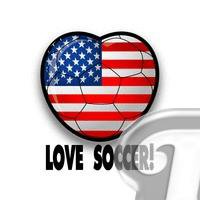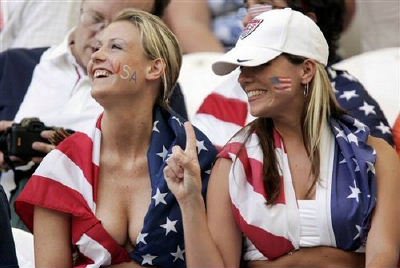An Overview of American Soccer History

The College Era, and Rules Consolidation, 1862-1875
The Working-Class and Immigrant Eras, 1875-1894
The First Dynasties, 1913-1921
The 1960's: The Birth of the American Soccer Renaissance
Outdoor soccer reaches a low: 1985
The Rebirth of Outdoor Soccer, 1988-1994
1994: The World Cup comes to America
From World Cup to Major League Soccer (1995-1996)

The Ethnic Period, 1933-1960
After the demise of the first American Soccer League, the game continued primarily on the semi-pro and amateur level, with many of the most successful teams being tied to ethnic communities and service clubs. Major amateur leagues included the National Soccer League of Chicago, the National Soccer League of New York, the new Jersey Soccer Association, the St. Louis Soccer League (by now reverted to semi-pro status), as well as numerous leagues in Southern New England and the greater New York and Philadelphia areas and other metropolitan areas. Soccer took a back seat as other sports shook off the depression and grew. Baseball was firmly established as the premier professional sport, as was Football as the main college spectator sport. Basketball continued as a series of regional semi pro leagues. Like Soccer, Basketball had established an American Basketball League in the 1920's, their first truly national league, only to see it fold during the early depression years to be revived as the ABL II on a smaller scale. Although Basketball took off after World War II, with the establishment of the NBL, and finally the NBA, soccer's new American League struggled to win a following outside of the local ethnic communities until the 1960's.
The second American Soccer League was started in 1933 as a complete reorganization of the remnants of the original league, but with a completely new lineup of teams. The league confined its presence to the New York/New Jersey/ Philadelphia region, and included mostly clubs long established at the amateur and semi-pro level, including old NAFBL standbys as Kearny Scots and Kearny Irish. The league in essence took the strongest teams from the local leagues and elevated them to a new competitive and financial level, although they were at best semi-pro both players holding other jobs to make ends meet. Former ASL I stars such as Billy Gonsalves and Bert Patenaude continued their careers in the ASL II, joined by younger stars such as Fabri Salcedo (goal scoring leader in 1938, 1941, and 1946), Nick Kropfelder and Walter Bahr. The first dynasty of the ASL II was the Kearny Scots who won five consecutive league titles from 1937-1941. Some of the long-lived teams of the early years included New York Americans, New York Brookhattan and Brooklyn Hispano.
On the International front, the US again made an appearance in the World Cup. Although Italy wanted to accept the USA, they had submitted their entry late, and so had to play a qualifier against the winner of the North American competition. That winner was Mexico, who had previously beat Cuba. The qualifier was played in Roma on May 24, 1934, and even though Mexico did not yet have full international standing, it was a well played game from the US point of view, a 4-2 victory that established future Hall of Fame inductee Aldo Donelli as one of the best American players of the era. The World Cup itself was a quick exit for the US who got pounded 7-1 by host Italy. Donelli scored the only US goal, but it should also be pointed out that Italy benefited from immigration rules that allowed them to field three players who had previously played for the Argentine national team. The US was thereby the only tam to play against both Luis Monti of Argentina in the 1930 World Cup and Luis Monti of Italy in the 1934 World Cup. Raimondo Orso, another Italy player, had also played for Argentina against the US in the 1928 Olympics.
During this era, the amateur and semipro leagues remained almost on a par with the ASL, as can be seen by their frequent victories in the National Open Challenge Cup. St. Louis was particularly successful with Stix, Baer & Fuller winning in 1933 and 1934, followed by Central Breweries in 1935. Later, Morgan Strasser of Pittsburgh became a perennial in the national championships. One major attraction during this time was the ASL sponsored tours by major foreign teams. These included the 1930 visit by Sportivo Buenos Aires, Botafogo FC of Brazil in 1941, Audan S.C. of Chile in 1933, Charlton Athletic in 1937, Liverpool in 1946, and 1948, Atlante FC of Mexico in 1940, Maccabi of Tel-Aviv in 1927 and 1936, Manchester United in 1950, 1952 and 1960.and Glasgow Rangers in 1928. Although the foreign teams usually won the games, the contests were exciting and eagerly awaited by the fans as their best chance to see truly top-level soccer.
All of the leagues were hard hit by World War II, with many players serving several years in the war effort. Leagues compensated as best they could with depleted rosters and players moving up from the amateur ranks. In 1945, the national governing body formally changed its name from the United States Football Association to the United States Soccer Football Association. After the war, there was a mini-boom among all sports in the US. In soccer, this was seen first by the return of players from the war effort, and also by the first modern attempt to create a professional soccer league on anything approaching a national scale. That attempt was the North American Soccer Football League, formed in 1946 by Fred Weiszman of Chicago, later replaced by Chicago White Sox General Manager Leslie O'Connor. This league included teams in St. Louis, Chicago, Pittsburgh, Detroit and Toronto. The league drew respectable crowds (in the 2,000-4,000 range) and several top-notch players including Gil Heron and Hall of Famer Nick D'Orio. The league only lasted two seasons due to financial difficulties, and the inability of some teams to show up for games during 1947. The Chicago Vikings won the National Challenge Cup in 1946, and they as well as the Pittsburgh Vikings continued to have success at the amateur level.
The 1950's started off with a bang as the US National team returned to the World Cup and stunned the world by defeating England 1-0 on a goal by Joe Gaetjens. Outside of this triumph, the sporting boom largely passed soccer by, as the game continued to lumber on at the local club level, with new dynasties being established by the Ukrainian Nationals of Philadelphia, the Philadelphia Americans, New York Hakoah and the Uhrik Truckers, all of whom won multiple league championships during this decade. The 1950's culminated with a move that would foreshadow the coming soccer boom -- the recognition of soccer as a sanctioned sport by the National Collegiate Athletic Association (NCAA), which proved to be a huge boom by pulling together the disparate college soccer conferences and providing a truly national championship for the first time. This move also spurred a continued boom in the college game as more and more institutions were encouraged to add soccer, or promote their club teams to varsity status.